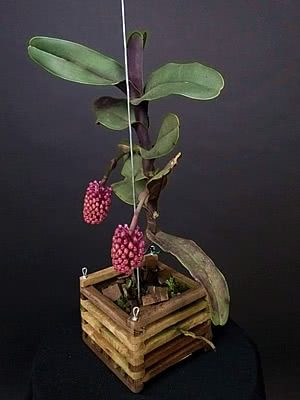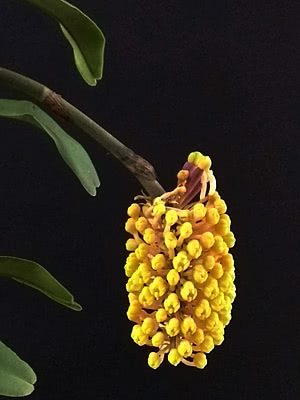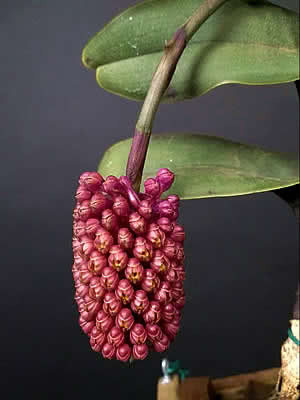The Robiquetia cerina is a natural orchid with monopodial growth, originating from the Philippines and Papua New Guinea. It primarily exhibits epiphytic behavior (grows on trees) and occasionally can be found as lithophytic (growing on rocks). The genus name, Robiquetia, pays homage to the French pharmacist Pierre Jean Robiquet (1780 – 1840), known for isolating caffeine and synthesizing codeine. As for the species name, cerina, it derives from the Latin term for “wax-like appearance,” alluding to the texture of the flowers.

Photo by Julio Cesar Zanatta
The R. cerina is a small-sized, slow-growing vanda orchid that can reach a length of up to 1 meter (3.28 feet). It blooms in late summer and throughout the autumn, producing one or more racemose, cone-shaped, pendant inflorescences, about 10 cm (3.94 inches) long, with 6 to 8 mm (0.24 to 0.31 inches) flowers that open one-third of the cluster at a time. The dense inflorescence bears resemblance to a pineapple. There are two varieties, one with red flowers and another with yellow flowers. The flowering period lasts approximately three weeks.
It should be cultivated under filtered light, with shading of 50 to 60%, high humidity (over 70%), and good ventilation. It thrives in warmth, preferring temperatures between 15 and 40ºC (59-104ºF). Its habitat is characterized by warm and humid forests at altitudes ranging from 50 to 70 meters (164-230 feet) above sea level. The recommended substrate for R. cerina consists of equal parts of pine bark, charcoal, and sphagnum moss. It prefers airy roots and perfect drainage, making it ideal to cultivate it in baskets rather than pots.

Photo by Julio Cesar Zanatta
Like all vandas, cultivate Robiquetia cerina in a hanging manner to preserve its root system and prevent damage to the pendant inflorescence. It requires ample atmospheric humidity and generous root watering, while maintaining quick drainage and good ventilation to avoid root rot and fungal diseases. Provide protection during colder winter days.
Weekly foliar fertilization is recommended during spring and summer using a solution of 2g (1 coffee spoon) of NPK Peter’s fertilizer with a 20-20-20 ratio per liter (0.26 gallons) of water. During autumn and winter, fertilization can be done every two weeks. Additionally, apply organic substrate fertilization once a month by sprinkling a coffee spoon of bokashi fertilizer over the surface. Propagation is possible through seeds.


